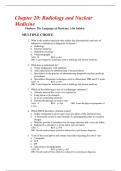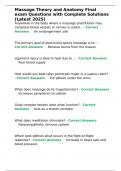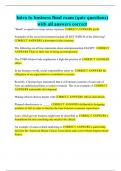Contents
Tutorial 1: Introduction to modern pricing strategies – Tuesday October 25th ................................................................. 2
Reading tutorial 1: Measuring price sensitivity by means of price elasticity ..................................................................... 7
Tutorial 2: Pricing individual products – Monday, October 31st. ......................................................................................... 9
Reading tutorial 2: Explore the dataset by using R ............................................................................................................ 16
Tutorial 3: Pricing with multiple products – Tuesday, November 8th ................................................................................ 18
Reading tutorial 3 .................................................................................................................................................................. 23
Tutorial 4: Psychological aspects of pricing – Monday, November 14th .......................................................................... 25
Reading tutorial 4: deriving cross price elasticities using regression analysis................................................................ 33
Tutorial 5: Price and promotions – Tuesday, November 22nd ........................................................................................... 34
Reading tutorial 5: Measuring promotion effectiveness with the scan*pro model ........................................................ 41
Tutorial 6: Price competition – Monday, November 28th ................................................................................................... 43
Reading tutorial 6: Measuring competitive reactions ........................................................................................................ 48
Tutorial 7: Special price settings – Monday, December 5th .............................................................................................. 49
1
,1.1 Why is pricing so hard?
Pricing is not just about fixing a price, you need to make a lot of strategic decisions: e.g. Whatsapp is free, Fortnite
is free but in the game itself you can buy things, etc. think about Zip car, people who want to use a car don’t have
to own a car, they pay a membership fee but each time they us Zip car, they also pay money.
Would you pay much more money to have (e.g.) a CT scan earlier? Probably, a hospital could benefit from that. but
that’s not a fair practice. So it shouldn’t be based on money. Philips realised that, since the price of these scanners
is very high, hospitals can usually only buy 1, or 2. They sit together with the hospital and proposed that instead of
selling the machines to the hospital, they have the opportunity to have some kind of service contract. They don’t
have to buy the machine anymore. In return, Philips gets paid for every patient that receives such a scan. In this
way, hospitals will be able to have more scanning machines, so the waiting time is way less. Philips can get a
continues stream from revenue each month from the hospital. So it’s a stable revenue stream for Philips. This is a
win-win-win situation for the hospital, Philips, and the patient.
For playgrounds, parents usually pay a certain fee for
each kid. The parents are usually free, and the
playgrounds get money from coffee/food from the
parents. It could also be the other way around.
Netflix has different plans with different features for the
consumers.
So pricing in itself is very complex.
1.2 Who is responsible for pricing in a firm?
Sales department? – Conduct customer/account negotiations
Marketing? – set list prices, brand considerations
Finance? – set payment terms
Accounting? – create invoices and assign discounts
→ In the end, nobody is responsible…
→ New role of Chief Pricing Officer (Next to CMO and CEO?)
Price should fit the overall firm strategy.
1.3 What factors enter the pricing decision?
= reasoned choice from a set of alternative prices to achieve a certain objective within a planning period
• Factors entering the pricing decisions:
o Internal factors
▪ Marketing objectives, marketing mix strategy, costs
o External factors:
▪ Nature market, competition, environment
Internal factors External factors
Marketing objectives Nature market:
• Maximize product profit • Perishable products
• Maximize product line profit • Consumer price elasticity
• Maximize category profit
• Maximize sales/market share
• Improve brand image
Marketing mix strategy Competition
• Consistency between all marketing activities • Number of competitors
for the brand (i.e. high quality-priced brand • Substitutability
• Promotional activities
Costs: Environment:
• Variable and fixed costs • Economic conditions (recession)
• Experience or learning curve • Government
• Retailers
Pricing is more an art than a science…
2
,2.1 Pricing: Guided by principles or driven by myths? – Based on the Hinterhuber Paper
Price setting often driven by “myths”
= Widely held and unquestioned beliefs that lack scientific basis
• See compulsory reading Hinterhuber (2016)
• Due to management misconceptions:
o Decision makers associate actions with desired outcome and a causal relation is inferred without
any formal evaluation of alternative actions
• Solution:
o Make you aware of these misconceptions
o Study scientific principles to guide pricing decisions
o Research and experimentation with prices!
2.2 The Six Myths
Pricing #1: Costs #2: Small #3: Customers are #4: products #5: high #6: Managing price
myth are the price highly price are difficult market share means changing
basis for changes have sensitive to = high profits prices
pricing little impact differentiate
Truth Pricing has Small price Customers are Even Market share Managing price
to be based changes have frequently unaware commodities and includes improving
on customer an extremely of prices paid in can be profitability systems, processes,
value significant business markets, differentiated are not skills ant to
effect on customers are more correlated communicate
company sensitive to total customer value. This
profitability costs of ownership can be done without
than price changing prices
Key Strive to Fight for Segment customers Treating Strive for Managing prices is far
learning understand pennies! based on their products as a leadership in more complex, and at
and create Successful needs commodity is customer the same time also
customer pricing means a self- insight, not simpler, than
value as a getting many fulfilling leadership in changing prices and
basis for small details prophecy market share required a true
pricing on many small organizational
transactions transformation
right
2.2.1 Myth 1 – Costs are the basis for pricing
• Examples: cost plus pricing (e.g., 20%), target pricing
• Most commonly used in practice: 80% of firms rely on costs to set prices
o Based on economic principle of fully efficient markets
▪ Firms go bankrupt if they sell below cost
▪ Price product at marginal cost
BUT Consumer’s Willingness to Pay (WTP) unrelated to cost:
Advantages Disadvantages
Simple method Not very profitable
(Variable) costs are known by firms Ignores brand positioning
Perceived ‘fairness’ Allocation of fixed cost not trivial
Easy to justify Expected demand id dependent on the price
2.2.2 Myth 2 - Small price changes have little impact
• 2 observations
o A 1% change in price will increase profits by 11%, on average
o A 10% price cut to customers often means taking a 50% or more cut in profits
o Large sales boosts from using 99-pricing (see class on psychological pricing)
→ Every reduction in price is taken directly from your profit!
• 2 solutions:
o Limit price negotiation authority of salesforce and marketers
o Artificially inflate price to make room for negotiation (cf. reference prices)
3
, 2.2.3 Myth 3 – Customers are highly price sensitive
• Consumers claim they value price (most) <> do not act this way…
• Firm price setters overestimate consumer price knowledge and price sensitivity
• Study results: (Dickson & Sawyer 1990, JM; Monroe ea 2015, IMM; Talukdar ea 2010, JR)
o 50% of shoppers could not name the price of the item placed in their shopping cart!
o Less than 1 in 2 shoppers was aware the product they purchased was on promotion
o Small price changes of < 2% tend to go unnoticed
o Cherry-pickers that ‘hunt’ for loss leaders < 2% of shoppers
o Price-driven consumer segments < 30% of your shoppers <> 70% choose based on OTHER benefits
• Business opportunities: customer segmentation, deal signalling, industrial markets value benefits OTHER
than price (e.g., efficiency, easy maintenance, etc…)
• 2 paradoxes
o In theory, when asked, customers are highly price sensitive; in reality; they are not
o Managers think customer price sensitivity is high, whereas in practice customer price sensitivity is
low.
2.2.4 Myth 4 – Products are difficult to differentiate
• There is no product that cannot be differentiated (no perfect competition)
• Examples: bottled water; gasoline; Shell V-power;…
2.2.5 Myth 5 – High market share = high profit
• See ‘competitor obsession bias’:
o Managers pursue competitor oriented goals <> profit oriented goals
• Strategy formulation – set relative <> absolute performance targets
But “Market leadership in itself is not worth a cent”
• Example: smartphone market
→ Strive for leadership in price premium <> ms
2.2.6 Myth 6 – Managing price means changing prices
• Communicating value more effective than changing price
How to enhance product value without changing prices?
o Emphasize unique features/ingredients
o Add product features
o Emphasize beneficial payment and delivery terms
o Emphasize quality over competing offerings
o Extend product warrantee
o Stress exclusivity
o Better frame your price
o Improve shopping environment/experience
2.3 Base pricing on scientific principles & experimentation!
• These pricing myths persist for decades…
→ Have been shown repeatedly to inhibit or hurt firm profitability!
• Solution:
o Make you aware of these misconceptions
o Study scientific principles to guide pricing decisions
o Research and experimentation with prices!
At its peak, General Motors (GM) had a 50% market share in the United States and was the world's largest
automaker from 1931 through 2007. With car brands like Opel and Chevrolet in its assortment, it is mainly active in
the lower-priced car segments. In 2005 the company posted a loss of US$10.6 billion. In 2009, the company filed
for a government backed Chapter 11 bankruptcy in June 2009.
• Pricing myth: customers are highly price sensitive
4
Tutorial 1: Introduction to modern pricing strategies – Tuesday October 25th ................................................................. 2
Reading tutorial 1: Measuring price sensitivity by means of price elasticity ..................................................................... 7
Tutorial 2: Pricing individual products – Monday, October 31st. ......................................................................................... 9
Reading tutorial 2: Explore the dataset by using R ............................................................................................................ 16
Tutorial 3: Pricing with multiple products – Tuesday, November 8th ................................................................................ 18
Reading tutorial 3 .................................................................................................................................................................. 23
Tutorial 4: Psychological aspects of pricing – Monday, November 14th .......................................................................... 25
Reading tutorial 4: deriving cross price elasticities using regression analysis................................................................ 33
Tutorial 5: Price and promotions – Tuesday, November 22nd ........................................................................................... 34
Reading tutorial 5: Measuring promotion effectiveness with the scan*pro model ........................................................ 41
Tutorial 6: Price competition – Monday, November 28th ................................................................................................... 43
Reading tutorial 6: Measuring competitive reactions ........................................................................................................ 48
Tutorial 7: Special price settings – Monday, December 5th .............................................................................................. 49
1
,1.1 Why is pricing so hard?
Pricing is not just about fixing a price, you need to make a lot of strategic decisions: e.g. Whatsapp is free, Fortnite
is free but in the game itself you can buy things, etc. think about Zip car, people who want to use a car don’t have
to own a car, they pay a membership fee but each time they us Zip car, they also pay money.
Would you pay much more money to have (e.g.) a CT scan earlier? Probably, a hospital could benefit from that. but
that’s not a fair practice. So it shouldn’t be based on money. Philips realised that, since the price of these scanners
is very high, hospitals can usually only buy 1, or 2. They sit together with the hospital and proposed that instead of
selling the machines to the hospital, they have the opportunity to have some kind of service contract. They don’t
have to buy the machine anymore. In return, Philips gets paid for every patient that receives such a scan. In this
way, hospitals will be able to have more scanning machines, so the waiting time is way less. Philips can get a
continues stream from revenue each month from the hospital. So it’s a stable revenue stream for Philips. This is a
win-win-win situation for the hospital, Philips, and the patient.
For playgrounds, parents usually pay a certain fee for
each kid. The parents are usually free, and the
playgrounds get money from coffee/food from the
parents. It could also be the other way around.
Netflix has different plans with different features for the
consumers.
So pricing in itself is very complex.
1.2 Who is responsible for pricing in a firm?
Sales department? – Conduct customer/account negotiations
Marketing? – set list prices, brand considerations
Finance? – set payment terms
Accounting? – create invoices and assign discounts
→ In the end, nobody is responsible…
→ New role of Chief Pricing Officer (Next to CMO and CEO?)
Price should fit the overall firm strategy.
1.3 What factors enter the pricing decision?
= reasoned choice from a set of alternative prices to achieve a certain objective within a planning period
• Factors entering the pricing decisions:
o Internal factors
▪ Marketing objectives, marketing mix strategy, costs
o External factors:
▪ Nature market, competition, environment
Internal factors External factors
Marketing objectives Nature market:
• Maximize product profit • Perishable products
• Maximize product line profit • Consumer price elasticity
• Maximize category profit
• Maximize sales/market share
• Improve brand image
Marketing mix strategy Competition
• Consistency between all marketing activities • Number of competitors
for the brand (i.e. high quality-priced brand • Substitutability
• Promotional activities
Costs: Environment:
• Variable and fixed costs • Economic conditions (recession)
• Experience or learning curve • Government
• Retailers
Pricing is more an art than a science…
2
,2.1 Pricing: Guided by principles or driven by myths? – Based on the Hinterhuber Paper
Price setting often driven by “myths”
= Widely held and unquestioned beliefs that lack scientific basis
• See compulsory reading Hinterhuber (2016)
• Due to management misconceptions:
o Decision makers associate actions with desired outcome and a causal relation is inferred without
any formal evaluation of alternative actions
• Solution:
o Make you aware of these misconceptions
o Study scientific principles to guide pricing decisions
o Research and experimentation with prices!
2.2 The Six Myths
Pricing #1: Costs #2: Small #3: Customers are #4: products #5: high #6: Managing price
myth are the price highly price are difficult market share means changing
basis for changes have sensitive to = high profits prices
pricing little impact differentiate
Truth Pricing has Small price Customers are Even Market share Managing price
to be based changes have frequently unaware commodities and includes improving
on customer an extremely of prices paid in can be profitability systems, processes,
value significant business markets, differentiated are not skills ant to
effect on customers are more correlated communicate
company sensitive to total customer value. This
profitability costs of ownership can be done without
than price changing prices
Key Strive to Fight for Segment customers Treating Strive for Managing prices is far
learning understand pennies! based on their products as a leadership in more complex, and at
and create Successful needs commodity is customer the same time also
customer pricing means a self- insight, not simpler, than
value as a getting many fulfilling leadership in changing prices and
basis for small details prophecy market share required a true
pricing on many small organizational
transactions transformation
right
2.2.1 Myth 1 – Costs are the basis for pricing
• Examples: cost plus pricing (e.g., 20%), target pricing
• Most commonly used in practice: 80% of firms rely on costs to set prices
o Based on economic principle of fully efficient markets
▪ Firms go bankrupt if they sell below cost
▪ Price product at marginal cost
BUT Consumer’s Willingness to Pay (WTP) unrelated to cost:
Advantages Disadvantages
Simple method Not very profitable
(Variable) costs are known by firms Ignores brand positioning
Perceived ‘fairness’ Allocation of fixed cost not trivial
Easy to justify Expected demand id dependent on the price
2.2.2 Myth 2 - Small price changes have little impact
• 2 observations
o A 1% change in price will increase profits by 11%, on average
o A 10% price cut to customers often means taking a 50% or more cut in profits
o Large sales boosts from using 99-pricing (see class on psychological pricing)
→ Every reduction in price is taken directly from your profit!
• 2 solutions:
o Limit price negotiation authority of salesforce and marketers
o Artificially inflate price to make room for negotiation (cf. reference prices)
3
, 2.2.3 Myth 3 – Customers are highly price sensitive
• Consumers claim they value price (most) <> do not act this way…
• Firm price setters overestimate consumer price knowledge and price sensitivity
• Study results: (Dickson & Sawyer 1990, JM; Monroe ea 2015, IMM; Talukdar ea 2010, JR)
o 50% of shoppers could not name the price of the item placed in their shopping cart!
o Less than 1 in 2 shoppers was aware the product they purchased was on promotion
o Small price changes of < 2% tend to go unnoticed
o Cherry-pickers that ‘hunt’ for loss leaders < 2% of shoppers
o Price-driven consumer segments < 30% of your shoppers <> 70% choose based on OTHER benefits
• Business opportunities: customer segmentation, deal signalling, industrial markets value benefits OTHER
than price (e.g., efficiency, easy maintenance, etc…)
• 2 paradoxes
o In theory, when asked, customers are highly price sensitive; in reality; they are not
o Managers think customer price sensitivity is high, whereas in practice customer price sensitivity is
low.
2.2.4 Myth 4 – Products are difficult to differentiate
• There is no product that cannot be differentiated (no perfect competition)
• Examples: bottled water; gasoline; Shell V-power;…
2.2.5 Myth 5 – High market share = high profit
• See ‘competitor obsession bias’:
o Managers pursue competitor oriented goals <> profit oriented goals
• Strategy formulation – set relative <> absolute performance targets
But “Market leadership in itself is not worth a cent”
• Example: smartphone market
→ Strive for leadership in price premium <> ms
2.2.6 Myth 6 – Managing price means changing prices
• Communicating value more effective than changing price
How to enhance product value without changing prices?
o Emphasize unique features/ingredients
o Add product features
o Emphasize beneficial payment and delivery terms
o Emphasize quality over competing offerings
o Extend product warrantee
o Stress exclusivity
o Better frame your price
o Improve shopping environment/experience
2.3 Base pricing on scientific principles & experimentation!
• These pricing myths persist for decades…
→ Have been shown repeatedly to inhibit or hurt firm profitability!
• Solution:
o Make you aware of these misconceptions
o Study scientific principles to guide pricing decisions
o Research and experimentation with prices!
At its peak, General Motors (GM) had a 50% market share in the United States and was the world's largest
automaker from 1931 through 2007. With car brands like Opel and Chevrolet in its assortment, it is mainly active in
the lower-priced car segments. In 2005 the company posted a loss of US$10.6 billion. In 2009, the company filed
for a government backed Chapter 11 bankruptcy in June 2009.
• Pricing myth: customers are highly price sensitive
4










